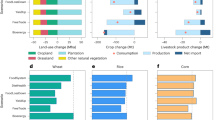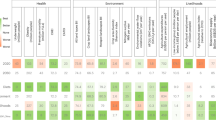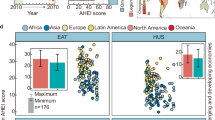Abstract
The transition to more sustainable diets is critical to achieve the Sustainable Development Goals and meet the Paris Agreement commitments. In China, this transition is particularly urgent due to the double burden of malnutrition and environmental degradation. In this study, we explored the potential of alternative diets in China to enhance public health, ensure food affordability and reduce adverse environmental impacts. We assessed these patterns through a multi-objective diet optimization model combined with an agro-economic modelling framework that captures key socio-economic and biophysical dynamics in China. The proposed healthy, affordable and low-environmental-impact diets substantially improve dietary quality and are projected to reduce food expenditures by 20–28% (US$128–186 capita−1 in power purchasing parities of 2005) by 2050. These diets also bring environmental benefits, including a 3–11% (4–13 Mha) expansion of non-forest natural vegetation area and modest biodiversity gains by 2050, a 9–40% (3–13 Gt CO2-equivalent) reduction in greenhouse gas emissions and a 5–12% (347–772 km3) decrease in freshwater withdrawals between 2020 and 2050. Our findings underscore the potential to achieve multiple co-benefits through long-term and target-oriented dietary transformations, while also balancing the transformation feasibility with achievable gains.
This is a preview of subscription content, access via your institution
Access options
Access Nature and 54 other Nature Portfolio journals
Get Nature+, our best-value online-access subscription
27,99 € / 30 days
cancel any time
Subscribe to this journal
Receive 12 digital issues and online access to articles
118,99 € per year
only 9,92 € per issue
Buy this article
- Purchase on SpringerLink
- Instant access to full article PDF
Prices may be subject to local taxes which are calculated during checkout





Similar content being viewed by others
Data availability
The data supporting the findings of this study can be found in Methods and Supplementary Information. Source data are provided with this paper.
Code availability
The MAgPIE code, including the food demand model, is available under GNU Affero General Public License, version 3 (AGPLv3) via GitHub at https://github.com/magpiemodel/magpie. The release (version 4.6.5) used in this paper is available via Zenodo at https://doi.org/10.5281/zenodo.7782037 (ref. 74). The technical model documentation is available at https://rse.pik-potsdam.de/doc/magpie/4.6.5/. Additional codes and details for the MODOpt model and MAgPIE-China are available from the corresponding author upon reasonable request.
References
Wang, X., Bodirsky, B. L., Müller, C., Chen, K. Z. & Yuan, C. The triple benefits of slimming and greening the Chinese food system. Nat. Food 3, 686–693 (2022).
Wang, X. et al. Global food nutrients analysis reveals alarming gaps and daunting challenges. Nat. Food 4, 1007–1017 (2023).
Crippa, M. et al. Food systems are responsible for a third of global anthropogenic GHG emissions. Nat. Food 2, 198–209 (2021).
Zhao, H. et al. China’s future food demand and its implications for trade and environment. Nat. Sustain. 4, 1042–1051 (2021).
Wang, X. et al. Bundled measures for China’s food system transformation reveal social and environmental co-benefits. Nat. Food 6, 72–84 (2025).
Tilman, D. & Clark, M. Global diets link environmental sustainability and human health. Nature 515, 518–522 (2014).
Springmann, M. et al. Health and nutritional aspects of sustainable diet strategies and their association with environmental impacts: a global modelling analysis with country-level detail. Lancet Planet. Health 2, e451–e461 (2018).
Eker, S., Reese, G. & Obersteiner, M. Modelling the drivers of a widespread shift to sustainable diets. Nat. Sustain. 2, 725–735 (2019).
Herforth, A. et al. A global review of food-based dietary guidelines. Adv. Nutr. 10, 590–605 (2019).
Willett, W. et al. Food in the Anthropocene: the EAT–Lancet Commission on healthy diets from sustainable food systems. Lancet 393, 447–492 (2019).
Sun, Z. et al. Dietary change in high-income nations alone can lead to substantial double climate dividend. Nat. Food 3, 29–37 (2022).
Gazan, R. et al. Mathematical optimization to explore tomorrow’s sustainable diets: a narrative review. Adv. Nutr. 9, 602–616 (2018).
Blackstone, N. T., El-Abbadi, N. H., McCabe, M. S., Griffin, T. S. & Nelson, M. E. Linking sustainability to the healthy eating patterns of the Dietary Guidelines for Americans: a modelling study. Lancet Planet. Health 2, e344–e352 (2018).
Breidenassel, C. et al. The Planetary Health Diet in contrast to the food-based dietary guidelines of the German Nutrition Society (DGE). Ernahr. Umsch. 69, 56–72 (2022).
Perignon, M. et al. How to meet nutritional recommendations and reduce diet environmental impact in the Mediterranean region? An optimization study to identify more sustainable diets in Tunisia. Glob. Food Sec. 23, 227–235 (2019).
The State of Food Security and Nutrition in the World 2020. Transforming Food Systems for Affordable Healthy Diets (FAO, IFAD, UNICEF, WFP and WHO, 2020); https://doi.org/10.4060/ca9692en
Guo, Y. et al. Environmental and human health trade-offs in potential Chinese dietary shifts. One Earth 5, 268–282 (2022).
Grummon, A. H., Lee, C. J. Y., Robinson, T. N., Rimm, E. B. & Rose, D. Simple dietary substitutions can reduce carbon footprints and improve dietary quality across diverse segments of the US population. Nat. Food 4, 966–977 (2023).
Bai, Y., Herforth, A. & Masters, W. A. Global variation in the cost of a nutrient-adequate diet by population group: an observational study. Lancet Planet. Health 6, e19–e28 (2022).
Liu, X. & Xin, L. A more plant-based diet can boost public health and reduce environmental impact in China. Food Sec. 16, 411–422 (2024).
Bodirsky, B. L. et al. The ongoing nutrition transition thwarts long-term targets for food security, public health and environmental protection. Sci. Rep. 10, 19778 (2020).
The Paris Agreement. United Nations https://www.un.org/en/climatechange/paris-agreement (2016).
SDG indicators data portal. FAO https://www.fao.org/sustainable-development-goals/indicators/211/zh/ (2022).
Dietrich, J. P. et al. MAgPIE 4—a modular open-source framework for modeling global land systems. Geosci. Model Dev. 12, 1299–1317 (2019).
Wang, X. et al. Reforming China’s fertilizer policies: implications for nitrogen pollution reduction and food security. Sustain. Sci. 18, 407–420 (2023).
Xu, H., Yue, C., Zhang, Y., Liu, D. & Piao, S. Forestation at the right time with the right species can generate persistent carbon benefits in China. Proc. Natl Acad. Sci. USA 120, e2304988120 (2023).
Veldman, J. W. et al. Where tree planting and forest expansion are bad for biodiversity and ecosystem services. BioScience 65, 1011–1018 (2015).
Chen, H. et al. Plant-based dietary patterns in relation to mortality among older adults in China. Nat. Aging 2, 224–230 (2022).
Vioque, J., Weinbrenner, T., Castelló, A., Asensio, L. & de la Hera, M. G. Intake of fruits and vegetables in relation to 10-year weight gain among Spanish adults. Obesity 16, 664–670 (2008).
John, J. H., Ziebland, S., Yudkin, P., Roe, L. S. & Neil, H. A. W. Effects of fruit and vegetable consumption on plasma antioxidant concentrations and blood pressure: a randomised controlled trial. Lancet 359, 1969–1974 (2002).
Boeing, H. et al. Critical review: vegetables and fruit in the prevention of chronic diseases. Eur. J. Nutr. 51, 637–663 (2012).
Afshin, A., Micha, R., Khatibzadeh, S. & Mozaffarian, D. Consumption of nuts and legumes and risk of incident ischemic heart disease, stroke, and diabetes: a systematic review and meta-analysis. Am. J. Clin. Nutr. 100, 278–288 (2014).
Feskens, E. J. M., Sluik, D. & van Woudenbergh, G. J. Meat consumption, diabetes, and its complications. Curr. Diab. Rep. 13, 298–306 (2013).
Meat consumption. OECD http://data.oecd.org/agroutput/meat-consumption.htm (2025).
Lee, J. E. et al. Meat intake and cause-specific mortality: a pooled analysis of Asian prospective cohort studies. Am. J. Clin. Nutr. 98, 1032–1041 (2013).
Bai, Y., Alemu, R., Block, S. A., Headey, D. & Masters, W. A. Cost and affordability of nutritious diets at retail prices: evidence from 177 countries. Food Policy 99, 101983 (2021).
IPCC Climate Change 2022: Mitigation of Climate Change (eds Shukla, P. R. et al.) (Cambridge Univ. Press, 2022).
Zhang, X. et al. Milk consumption and multiple health outcomes: umbrella review of systematic reviews and meta-analyses in humans. Nutr. Metab. 18, 7 (2021).
Storhaug, C. L., Fosse, S. K. & Fadnes, L. T. Country, regional, and global estimates for lactose malabsorption in adults: a systematic review and meta-analysis. Lancet Gastroenterol. Hepatol. 2, 738–746 (2017).
Herrero, M. et al. Innovation can accelerate the transition towards a sustainable food system. Nat. Food 1, 266–272 (2020).
Fu, H., Li, Y., Jiang, P., Zhou, S. & Liao, C. Transition towards sustainable diets: multi-objective optimization of dietary pattern in China. Sustain. Prod. Consum. 48, 14–28 (2024).
Farm to Fork Strategy. European Commission https://food.ec.europa.eu/horizontal-topics/farm-fork-strategy_en (2020).
Lu, L., Anderson-Cook, C. M. & Robinson, T. J. Optimization of designed experiments based on multiple criteria utilizing a Pareto frontier. Technometrics 53, 353–365 (2011).
Chinese Nutrition Society Chinese Dietary Guideline (2022) (People’s Medical Publishing House, 2022).
Platform for Commercial Information Forcasting (Ministry of Commerce, People’s Republic of China, 2025); https://cif.mofcom.gov.cn/cif/html/
Key Agricultural Products Market Information Platform (Ministry of Agriculture and Rural Affairs, People’s Republic of China, 2025); https://ncpscxx.moa.gov.cn/#/indexPage
Cai, H. et al. Environmental footprints of Chinese foods and beverages: literature-based construction of a LCA database. Data Brief 42, 108244 (2022).
Cai, H. et al. Chinese Food Life Cycle Assessment Database (Wageningen University, 2022).
Poore, J. & Nemecek, T. Reducing food’s environmental impacts through producers and consumers. Science 360, 987–992 (2018).
Clark, M. et al. Estimating the environmental impacts of 57,000 food products. Proc. Natl Acad. Sci. USA 119, e2120584119 (2022).
National Nutrient Database for Standard Reference, Release 28. Nutrients: Vitamin C, Total Ascorbic Acid (USDA, 2015).
Chinese Nutrition Society Dietary Reference Intakes for China (2023) (People’s Medical Publishing House, 2023).
Meyers, L. D. et al. Dietary Reference Intakes: The Essential Guide to Nutrient Requirements (National Academies, 2006).
Infant and young child feeding. WHO https://www.who.int/news-room/fact-sheets/detail/infant-and-young-child-feeding (2023).
Lotze-Campen, H. et al. Global food demand, productivity growth, and the scarcity of land and water resources: a spatially explicit mathematical programming approach. Agric. Econ. 39, 325–338 (2008).
FAOSTAT Database (FAO, 2016).
Cederberg, C. & Sonesson, U. Global Food Losses and Food Waste—Extent, Causes and Prevention (FAO, 2011).
O’Neill, B. C. et al. The roads ahead: narratives for shared socioeconomic pathways describing world futures in the 21st century. Glob. Environ. Change 42, 169–180 (2017).
Schaphoff, S. et al. LPJmL4—a dynamic global vegetation model with managed land—part 1: model description. Geosci. Model Dev. 11, 1343–1375 (2018).
Dietrich, J. P., Schmitz, C., Lotze-Campen, H., Popp, A. & Müller, C. Forecasting technological change in agriculture—an endogenous implementation in a global land use model. Technol. Forecast Soc. Change 81, 236–249 (2014).
IPCC 2019 Refinement to the 2006 IPCC Guidelines for National Greenhouse Gas Inventories (eds Calvo Buendia, E. et al.) (IPCC, 2019).
Leclère, D. et al. Bending the curve of terrestrial biodiversity needs an integrated strategy. Nature 585, 551–556 (2020).
Scholes, R. J. & Biggs, R. A biodiversity intactness index. Nature 434, 45–49 (2005).
Purvis, A. et al. in Advances in Ecological Research Vol. 58 (eds Bohan, D. A. et al.) 201–241 (Academic, 2018).
Schmitz, C. et al. Blue water scarcity and the economic impacts of future agricultural trade and demand. Water Resour. Res. 49, 3601–3617 (2013).
von Bloh, W. et al. Implementing the nitrogen cycle into the dynamic global vegetation, hydrology, and crop growth model LPJmL (version 5.0). Geosci. Model Dev. 11, 2789–2812 (2018).
Wang, X. et al. Assessing the impacts of technological change on food security and climate change mitigation in China’s agriculture and land-use sectors. Environ. Impact Assess. Rev. 107, 107550 (2024).
Knuppel, A., Papier, K., Key, T. J. & Travis, R. C. EAT-Lancet score and major health outcomes: the EPIC-Oxford study. Lancet 394, 213–214 (2019).
Zhou, J., Leepromrath, S. & Zhou, D. Dietary diversity indices v. dietary guideline-based indices and their associations with non-communicable diseases, overweight and energy intake: evidence from China. Public Health Nutr. 26, 911–933 (2023).
Xiao, Y. et al. Association between adherence to EAT-Lancet diet and incidence and mortality of lung cancer: a prospective cohort study. Cancer Sci. 114, 4433–4444 (2023).
Yuan, Y.-Q. et al. The development of a Chinese Healthy Eating Index and its application in the general population. Nutrients 9, 977 (2017).
R Core Team. R: a language and environment for statistical computing. https://www.r-project.org/ (R Foundation for Statistical Computing, 2024).
General Algebraic Modeling System (GAMS) release 42.5.0. https://www.gams.com/42/ (GAMS Development Corporation, 2023).
Dietrich, J. P. et al. MAgPIE—an open source land-use modeling framework. Zenodo https://doi.org/10.5281/zenodo.7782037 (2023).
Acknowledgements
X.W., H.C. and J.X. were supported by the National Science Foundation of China (grant nos 72273126 and 72134006) and the National Key Research and Development Program of China (grant no. 2020YFA0608604). X.W., C.Y., H.C. and J.X. acknowledge support from the Fundamental Research Funds for the Central Universities. We thank W. Lu from the Department of Agricultural Economics and Management, Zhejiang University for providing valuable suggestions during the conceptualization of this work. We also thank M. Obersteiner and H. C. J. Godfray at the University of Oxford and C. Yue at Northwest Agriculture and Forestry University for insights during the revision.
Author information
Authors and Affiliations
Contributions
X.W., C.Y., H.L.-C. and H.C. conceptualized the study. X.W., H.C., J.X., C.Y., B.L.B., M.S., J.P.D., A.P. and H.L.-C. contributed data and devised the methodology. H.C., J.X., X.W. and C.Y. performed the analysis and interpreted the results. H.C., J.X. and X.W. produced the visualizations. X.W. acquired the funding and managed the project administration. H.C., J.X. and X.W. wrote the original draft of the paper. All authors participated in discussing the results and contributed to reviewing and editing the paper.
Corresponding author
Ethics declarations
Competing interests
The authors declare no competing interests.
Peer review
Peer review information
Nature Sustainability thanks Kostas Dellis, Liangjie Xin and the other, anonymous, reviewer(s) for their contribution to the peer review of this work.
Additional information
Publisher’s note Springer Nature remains neutral with regard to jurisdictional claims in published maps and institutional affiliations.
Extended data
Extended Data Fig. 1 Food intakes in terms of aggregated food groups in three alternative diets for specific gender and age group.
Each panel shows food intakes of a specific demographic group in the three alternative dietary scenarios.
Extended Data Fig. 2 Overall demand in 2050 in terms of different demand types for aggregated food groups in the reference and three alternative scenarios.
There are eight demand types including food, feed, processed, other utilization, bioenergy, seed, waste, and domestic balance flow considered in MAgPIE.
Extended Data Fig. 3 Expenditures on different food groups in MAgPIE-China in the reference and three alternative scenarios between 2020 and 2050.
a. Food expenditures in the reference scenario. b. Food expenditures in the HEALCDG scenario. c. Food expenditures in the HEALEAT scenario. d. Food expenditures in the HEALbase scenario.
Supplementary information
Supplementary Information
Supplementary Methods, Figs. 1–32, Tables 1–8 and references.
Source data
Source Data Fig. 1
Source data from the model results to generate Fig. 1.
Source Data Fig. 2
Source data from the model results to generate Fig. 2.
Source Data Fig. 3
Source data from the model results to generate Fig. 3.
Source Data Fig. 4
Source data from the model results to generate Fig. 4.
Source Data Fig. 5
Source data from the model results to generate Fig. 5.
Source Data Extended Data Fig. 1
Source data from the model results to generate Extended Data Fig. 1.
Source Data Extended Data Fig. 2
Source data from the model results to generate Extended Data Fig. 2.
Source Data Extended Data Fig. 3
Source data from the model results to generate Extended Data Fig. 3.
Rights and permissions
Springer Nature or its licensor (e.g. a society or other partner) holds exclusive rights to this article under a publishing agreement with the author(s) or other rightsholder(s); author self-archiving of the accepted manuscript version of this article is solely governed by the terms of such publishing agreement and applicable law.
About this article
Cite this article
Cai, H., Xuan, J., Wang, X. et al. The multiple benefits of Chinese dietary transformation. Nat Sustain 8, 606–618 (2025). https://doi.org/10.1038/s41893-025-01560-6
Received:
Accepted:
Published:
Issue Date:
DOI: https://doi.org/10.1038/s41893-025-01560-6



